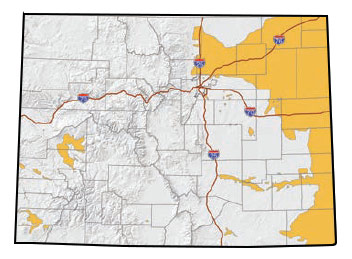
Pheasant Habitat Basics
Whether you are a pheasant hunter making plans for a fall hunting trip, or a landowner planning your next habitat project, one of the keys to success is a basic understanding of the various types of habitat that pheasants use throughout the year.
If you’re interested in a pheasant habitat project on your land, contact the Pheasant Habitat Improvement Program (PHIP) office at 970-521-0233. Find out more about PHIP.
Conservation Reserve Program Fields
The Conservation Reserve Program, commonly known as CRP, is administered by the United States Department of Agriculture's Farm Service Agency. Landowners offer their land for enrollment, and when accepted, agree to establish cover for the life of the agreement, in return for an annual rental payment. CRP fields, when seeded to beneficial cover, can be critical habitat for many species of wildlife.
CRP Fields are the most predictable habitat, as they provide areas for nesting, brooding and wintering pheasants. Cover quality in CRP fields can be extremely variable, depending on the age of the field, the grass mix planted and impacts of recent droughts and/or management prescriptions.
Keys to Pheasant Abundance in CRP
New CRP fields that are planted next to a sorghum cover crop, or young stands of CRP still dominated by annual weeds, are normally the most productive fields for hunting pheasants.
As grass begins to take over a field, pheasant abundance generally declines but can be very good if weeds and alfalfa are present in the field. Expect pheasants to leave these fields to feed in adjacent fields, but to return at night to roost and to loaf during the day.
Mature grass stands can be great for pheasants, but birds usually rely on adjacent lands to provide brood habitat and food sources. The key is to find mature fields with switchgrass and yellow Indian grass (look for orange and red colored grasses), next to crop stubble.
Poor quality CRP can be productive, as some pheasants prefer to night-roost in thin cover.
Pay attention to adjacent crop field for food sources and alternative roosting cover, in addition to woody cover.
Non-irrigated Cropland
Non-irrigated cropland is often the wild card in Colorado pheasant hunting. When conditions are right, dryland crop fields can support excellent numbers of pheasants. When conditions are poor, populations quickly decline. For fall pheasant concentrations, wheat stubble and milo stubble (in southeast Colorado) are most important. Some things to look for include:
Stubble height — 15- to 30-inch stubble is optimal for pheasants and hunting.
Weed growth in the stubble is equally important to stubble height. Look for fields that offer sunflowers or kochia.
The height and density of cover in the field. Generally, the more cover, the better potential for the field.
Irrigated Areas
Irrigated areas can be good or bad. Some ideas for finding pheasants in irrigated agriculture lands include:
Don’t expect many pheasants where irrigated alfalfa dominates the landscape.
Transition areas where center-pivot corn irrigation mixes with dryland wheat production often produce our highest pheasant populations. Pheasants nest in the wheat fields, raise chicks in standing corn and, once the corn is harvested, the birds go back into nearby wheat stubble or CRP to roost, returning daily to forage in corn fields.
Pheasant Hunting Colorado: A Guide to Hunting Techniques & Habitat
Strategy
Once you have found an area that holds pheasants or quail, the hunting strategy you use will probably be the largest factor in your success. These suggestions come from our observation of hunters in the field.
Move Quickly & Quietly
Prepare to execute your hunt plan quickly and quietly. Too often hunters
pull up to a field, slam the doors, let the dogs out, then talk about how to hunt the field.
That works with young birds on opening day, but after a few shots have
been fired, wary birds will be implementing their own escape strategy as
soon
as they are aware of your presence.
Timing Matters
Hunt fields at the right time of day. In the morning and evening, birds will be moving from roosting sites towards food.
Put yourself and your hunting party between the birds and their food source, and hunt towards the roosting areas, or vice versa when birds are
leaving feeding areas in the afternoon.
Some fields offer birds everything they need and can be hunted from daylight until dusk, but normally, pheasants and quail use different fields
to meet their daily requirements.
Don't Get Pushy
Avoid pushing birds to other good quality fields if possible. Rarely will a wise rooster or covey of scaled quail flush when they can run into good
escape cover. Pay attention to how they beat you (they will) and devise ways to cover escape routes next time.
A good strategy for hunting running pheasants is to push them towards thin cover, forcing some of them to hold. Scaled quail, however, can be pushed towards.

